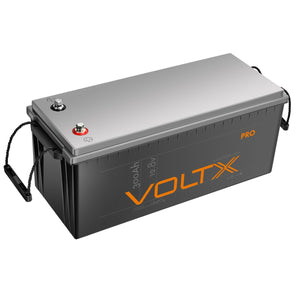When venturing into Australia's vast outback or coastal regions, reliable power becomes your lifeline for comfort and safety. A 300Ah lithium battery transforms how adventurers experience off-grid living, providing the sustained energy needed for extended journeys through remote locations. Whether you're powering a caravan through the Simpson Desert, running essential equipment in your camper trailer along the Great Ocean Road, or maintaining your solar setup at an off-grid cabin in Tasmania, this high-capacity 12V 300Ah lithium battery delivers the freedom to explore without compromise.
Marine enthusiasts navigating Australia's extensive coastline particularly value the dependability of lithium marine batteries within this capacity, whilst camping aficionados appreciate how this lithium camping battery keeps their fridges running and lights glowing throughout multi-day expeditions. Furthermore, 300Ah lithium solar batteries are perfect for sustainable off-grid living, offering reliable, high-capacity storage that allows Australians to harness the sun’s energy even in the most remote corners of the country.
Advantages of 300Ah Lithium Battery
A 300Ah lithium battery marks a significant advancement in battery chemistry, offering advantages that traditional lead-acid batteries simply cannot match. A significantly longer lifespan, fast charging capabilities and a higher energy density are a few noteworthy. This translates to reliable power, lower maintenance costs, and a more efficient energy storage solution. The LiFePO4 300Ah configuration weighs approximately 60% less than equivalent lead-acid batteries, a crucial advantage when every kilogram matters in your caravan or boat setup. Perhaps most importantly, these batteries maintain consistent voltage output throughout their discharge cycle, ensuring your sensitive electronics and appliances receive stable power delivery from first use to the final amp-hour.
Key Specifications and Design
The engineering quality of a high-performance 300Ah battery is evident in its features tailored for the challenging Australian environment and rigorous applications. This battery offers a full 300 amp-hours of usable capacity at a standard 12-volt output, equating to 3,840 watt-hours of energy stored for prolonged off-grid living. If you’re going for a LiFePO4, the lithium 300Ah battery construction typically features an advanced Battery Management System (BMS) that optimises battery cells and shields against common issues like overcharging.
Modern lightweight 300Ah lithium battery designs achieve this massive capacity whilst maintaining a manageable 30-35 kg weight, incorporating robust terminals and weather-resistant casings that withstand the vibrations of corrugated roads and the salt spray of coastal environments. The compact form factor of these units, often measuring around 520mm x 270mm x 220mm, allows for versatile mounting options in tight spaces where traditional batteries simply wouldn't fit.
Reliability and Value for Australian Conditions
A 300Ah lithium battery provides excellent dependability and value suited to Australian environments, especially for off-grid scenarios and activities such as caravanning and camping. These batteries are built for deep cycling, allowing for frequent discharges and recharges without considerable degradation in performance, and they boast a longer lifespan than conventional lead-acid batteries.
Some providers even offer comprehensive warranties, reflecting their confidence in LiFePO4 technology's durability and covering defects or performance issues that rarely occur with quality units designed for Australian conditions. When considering 300Ah lithium battery price factors, the extended lifespan translates to a lower cost per cycle compared to any alternative technology, with many users reporting 10+ years of reliable service in demanding applications. These lithium leisure battery 300Ah units excel in temperature extremes from -20°C to 60°C, maintaining performance whether you're skiing in the Snowy Mountains or exploring the Red Centre during summer.
Getting the Right Power Solution
Selecting the ideal 300Ah lithium batteries for Australian adventures requires understanding how advanced 12V 300Ah lithium battery technology aligns with your specific power needs and usage patterns. The combination of massive capacity, cutting-edge LiFePO4 battery chemistry, exceptional warranty protection, and customer-friendly policies creates a compelling package for serious off-grid enthusiasts. The best lithium battery solutions should empower you to venture further, stay longer, and enjoy greater comfort wherever your journey leads, knowing that reliable power supports every moment of your adventure. The investment in quality lithium technology pays dividends through years of dependable service, reduced weight in your setup, faster charging times, and the confidence that comes from choosing a battery engineered to excel in Australian conditions.
Frequently Asked Questions
- How long will a 300Ah battery power typical devices in a caravan or camp setup?
A 300Ah lithium battery can power a 60L camping fridge (averaging 40W) for approximately 90-100 hours, LED lights (10W total) for 300+ hours, or a combination of devices totalling 100W continuous draw for about 36 hours. Your actual runtime depends on device efficiency, ambient temperature, and usage patterns, but the usable capacity of a 12V 300Ah lithium battery far exceeds traditional batteries.
- What size inverter is recommended for a 300Ah battery system?
For a 300 amp lithium battery, a 2000-3000W inverter provides optimal performance for most applications. The battery can safely deliver up to 200A continuous current (2400W at 12V), though staying below 150A extends battery life. Consider your peak power requirements and simultaneous device usage when selecting inverter capacity.
- How do I properly charge a 300Ah LiFePO4 battery?
Charging a LiFePO4 battery requires a compatible lithium battery charger with the correct charging profile (14.4-14.6V bulk/absorption, 13.6V float). A 50-60A charger provides efficient charging in 5-6 hours, whilst solar panels with an appropriate MPPT charge controller offer sustainable charging. Always ensure your charging equipment specifies compatibility with LiFePO4 chemistry.
- Can I connect multiple 300Ah batteries in series or parallel?
Most quality 300Ah lithium battery units support both configurations. Parallel connections increase capacity whilst maintaining 12V (e.g., two batteries = 600Ah at 12V), while series connections increase voltage (e.g., two batteries = 300Ah at 24V). Always use identical batteries and follow manufacturer guidelines for safe installation.
- What is the expected lifespan of a 300Ah LiFePO4 battery compared to other types?
A quality LiFePO4 300Ah battery typically provides 4,000-6,000 cycles at 80% depth of discharge, translating to 10-15 years of daily use. This dramatically exceeds AGM batteries (500-800 cycles) and flooded lead-acid (300-500 cycles), making the lithium ion battery 12V 300Ah a superior long-term investment despite higher initial cost.
- Is a 300Ah battery suitable for starting an engine, or is it purely for deep cycle use?
Lithium deep cycle battery units are optimised for steady, long-duration power delivery rather than the high-burst currents required for engine starting. Whilst some models can start engines, dedicated deep cycle batteries excel at running appliances, electronics, and inverters over extended periods. Use a separate cranking battery for engine starting when needed.
- How much does a 300Ah lithium battery typically weigh?
A lightweight 300ah lithium battery typically weighs 30-35kg, approximately 60% less than equivalent AGM batteries (80-90kg) and 70% less than flooded lead-acid (100-110kg). This significant weight reduction improves vehicle handling, increases payload capacity, and simplifies installation in challenging mounting locations.
- What are the safety features of a LiFePO4 battery?
Modern LiFePO4 battery technology incorporates multiple safety layers including integrated Battery Management Systems (BMS) that prevent overcharging, over-discharging, overcurrent, and short circuits. The inherently stable lithium iron phosphate chemistry resists thermal runaway, making these batteries exceptionally safe even under extreme conditions or physical damage.
- How does the warranty process work for 300Ah lithium batteries?
Quality lithium batteries typically come with a 5-year warranty, covering manufacturing defects and significant capacity loss (usually defined as dropping below 80% of the original rated capacity). Warranty claims usually require proof of purchase and some basic diagnostic details. Many suppliers also offer a 30 to 60-day return window, allowing you to test the battery in your setup before fully committing.
- Is lithium better than AGM for off-grid or deep cycle applications?
For off-grid applications, lithium RV battery 300Ah units offer superior performance across every metric: 3-5 times longer lifespan, 60% weight reduction, faster charging, deeper usable capacity (80-90% vs 50%), and better performance in extreme temperatures. Whilst AGM batteries cost less initially, lithium provides better value over the system lifetime.
- What maintenance is required for a 300Ah LiFePO4 battery?
Unlike lead-acid batteries, a 12V 300Ah LiFePO4 battery requires virtually no maintenance—no water topping, no equalisation charges, and no terminal corrosion issues. Simply keep terminals clean, store partially charged if unused for extended periods, and avoid extreme overcharging or deep discharge below BMS cut-off points.
- Can a 300Ah battery be used in cold or hot Australian climates?
Yes, quality 300Ah lithium batteries are designed to perform reliably in Australia’s wide-ranging climates, from -20°C to 60°C. Many models include built-in thermal management via the Battery Management System (BMS), and some even feature internal heaters for safe charging in sub-zero conditions. Unlike lead-acid batteries, lithium batteries maintain consistent performance and capacity in both hot and cold environments.
Frequently Asked Questions
- How long will a 300Ah battery power typical devices in a caravan or camp setup?
- What size inverter is recommended for a 300Ah battery system?
- What maintenance is required for a 300Ah LiFePO4 battery?
- Can a 300Ah battery be used in cold or hot Australian climates?
- How do I properly charge a 300Ah LiFePO4 battery?
- Can I connect multiple 300Ah batteries in series or parallel?
- What is the expected lifespan of a 300Ah LiFePO4 battery compared to other types?
- Is a 300Ah battery suitable for starting an engine, or is it purely for deep cycle use?
- How much does a 300Ah lithium battery typically weigh?
- What are the safety features of a LiFePO4 battery?
- How does the warranty process work for 300Ah lithium batteries?
- Is lithium better than AGM for off-grid or deep cycle applications?


